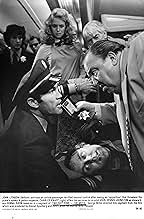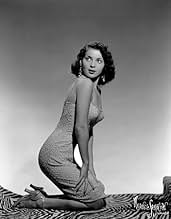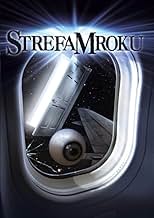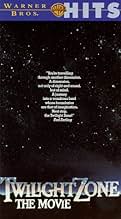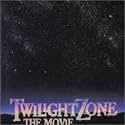VALUTAZIONE IMDb
6,5/10
43.423
LA TUA VALUTAZIONE
Quattro storie di orrore e fantascienza, ognuna delle quali è una nuova versione di un classico.Quattro storie di orrore e fantascienza, ognuna delle quali è una nuova versione di un classico.Quattro storie di orrore e fantascienza, ognuna delle quali è una nuova versione di un classico.
- Premi
- 1 vittoria e 8 candidature totali
Rainer Peets
- German Officer (segment "Time Out")
- (as Remus Peets)
William S. Taylor
- G.I. (segment "Time Out")
- (as William B. Taylor)
Recensioni in evidenza
Five episodes realized as tribute to Rod Serling's Twilight zone, made by four known directors . It's is divided into 4 parts , three of them real remakes from classic television series, though starts in a prologue stars Albert Brooks and Dan Aykroyd . The best directed by John Landis is the first, where a bigot (played by Vic Morrow who died during filming by a helicopter crash accident) who becomes pursued of evil Nazis, Ku Klux Klan and American soldiers in Vietnam. The second segment directed by Steven Spielberg is a silly story about old people living in a retirement house who turn into little boys, thanks a strange visitor (Scatman Crothers). The third directed by Joe Dante concerns about a young woman (Kathleen Quinlan) encounters a kid with rare powers and some people (Kevin McCarthy, William Schallert,among them) closed at a strange house. And fourth episode titled 'Nightmare at 20.000 Feet' deals with a terrified passenger(John Lightow) who watch a creepy monster making rare issues on the wing of the plane.
The picture contains good special effects in traditional style without excessive computer generator as usual nowadays. The master Jerry Goldsmith composes a magic musical score particularly reflected on the second episode titled 'Kick the can' . Colorful and imaginative cinematography especially in the third segment titled 'It's a good life'. Rating : Acceptable and passable, the picture will appeal to fantastic genre buffs.
The classic long-running television series is formed by 156 episodes and its narrator , of course, Rod Serling. Later on, in 2002 are realized 44 new episodes with Forest Whitaker as host.
The picture contains good special effects in traditional style without excessive computer generator as usual nowadays. The master Jerry Goldsmith composes a magic musical score particularly reflected on the second episode titled 'Kick the can' . Colorful and imaginative cinematography especially in the third segment titled 'It's a good life'. Rating : Acceptable and passable, the picture will appeal to fantastic genre buffs.
The classic long-running television series is formed by 156 episodes and its narrator , of course, Rod Serling. Later on, in 2002 are realized 44 new episodes with Forest Whitaker as host.
Feature film expansion of legendary TV series is uneven overall, but it does have its moments, and it does thankfully follow the rule of saving the best for last. Four prominent directors are brought together to create, in glorious colour, some classic episodes of the series, with an impressive roster of stars and character players. At least along the way it manages to create some enjoyable jolts. Burgess Meredith, star of 'Time Enough at Last', one of the best known and most beloved of all episodes, is the narrator for this trip into some bizarre places.
Unfortunately the movie will always have an enormous stigma attached to it due to the untimely and horrific death of actor Vic Morrow and two child extras during the shooting of Segment 1. That may very well leave a bad taste in the mouth of many people watching. It's up to the individual viewer as to how much this affects their enjoyment of the film.
The prologue and the first segment are actually originals written by director John Landis. Dan Aykroyd and Albert Brooks are fun as a passenger and driver who come up some with some amusing ways to entertain each other until Aykroyd decides it's time for Brooks to get a good scare. This gets us off to a good start because Landis does understand that with the TV show the payoff was a most important element.
Segment 1 sees Morrow playing an unrepentant bigot who gets a major dose of his own intolerance when he's mistaken for a Jew by Nazis, a black by KKK members, and a Vietnamese man by American troops in 'Nam. This is a very dark episode that doesn't end too satisfactorily, but Morrow is excellent, the look of Paris during WWII is nicely realized, the pacing is effective, and there's a great in joke referring back to Landis's "Animal House".
Segment 2, Steven Spielberg's remake of "Kick the Can", sees wonderfully genial Scatman Crothers injecting some magic into the lives of senior citizens in an old folks' home. Like Segment 1, it's unfortunately not subtle about its message, and is so syrupy sweet that it really doesn't fit in with the other segments here. The actors are very likable, fortunately; Crothers manages to make it worth sitting through.
Segment 3 tells the tale of "It's a Boy's Life", in which a creepy kid (Jeremy Licht) makes the acquaintance of travelling schoolteacher Kathleen Quinlan. This kid can bend reality to suit his whims, lives in a house with bizarre designs, likes his hamburgers with peanut butter topping, and lives for cartoons. And his "family" lives in mortal terror of him. The work of Joe Dante, this serves as a counterpoint to Spielberg's tale the way that it depicts childish fantasies run amok. Great cartoon style monster work by Rob Bottin helps in the enjoyment of this segment; this is where the film starts getting really good. Bill Mumy, the kid in the original episode, plays a diner patron.
Segment 4, directed by George Miller of the "Mad Max" series, is far and away the best, an over the top remake of "Nightmare at 20,000 Feet", in which terrified airplane passenger John Lithgow believes he sees a creature busy destroying the planes' engines as it flies through a storm. Lots of good atmosphere and intensity here, with a top notch unhinged performance by Lithgow and a great creature, designed by Craig Reardon & Michael McCracken and performed by actor Larry Cedar.
With a lot of familiar faces in the small roles (ex. Charles Hallahan, Doug McGrath, Bill Quinn, Selma Diamond, the almighty Dick Miller (once again playing 'Walter Paisley'), Kevin McCarthy, William Schallert, Cherie Currie, Nancy Cartwright, John Dennis Johnston, Eduard Franz, and Donna Dixon), and wonderful music by Jerry Goldsmith, this certainly remains an entertaining film to watch for its duration, if not a great one. Hopefully it will inspire people to check out the TV series and see why it's so admired.
Seven out of 10.
Unfortunately the movie will always have an enormous stigma attached to it due to the untimely and horrific death of actor Vic Morrow and two child extras during the shooting of Segment 1. That may very well leave a bad taste in the mouth of many people watching. It's up to the individual viewer as to how much this affects their enjoyment of the film.
The prologue and the first segment are actually originals written by director John Landis. Dan Aykroyd and Albert Brooks are fun as a passenger and driver who come up some with some amusing ways to entertain each other until Aykroyd decides it's time for Brooks to get a good scare. This gets us off to a good start because Landis does understand that with the TV show the payoff was a most important element.
Segment 1 sees Morrow playing an unrepentant bigot who gets a major dose of his own intolerance when he's mistaken for a Jew by Nazis, a black by KKK members, and a Vietnamese man by American troops in 'Nam. This is a very dark episode that doesn't end too satisfactorily, but Morrow is excellent, the look of Paris during WWII is nicely realized, the pacing is effective, and there's a great in joke referring back to Landis's "Animal House".
Segment 2, Steven Spielberg's remake of "Kick the Can", sees wonderfully genial Scatman Crothers injecting some magic into the lives of senior citizens in an old folks' home. Like Segment 1, it's unfortunately not subtle about its message, and is so syrupy sweet that it really doesn't fit in with the other segments here. The actors are very likable, fortunately; Crothers manages to make it worth sitting through.
Segment 3 tells the tale of "It's a Boy's Life", in which a creepy kid (Jeremy Licht) makes the acquaintance of travelling schoolteacher Kathleen Quinlan. This kid can bend reality to suit his whims, lives in a house with bizarre designs, likes his hamburgers with peanut butter topping, and lives for cartoons. And his "family" lives in mortal terror of him. The work of Joe Dante, this serves as a counterpoint to Spielberg's tale the way that it depicts childish fantasies run amok. Great cartoon style monster work by Rob Bottin helps in the enjoyment of this segment; this is where the film starts getting really good. Bill Mumy, the kid in the original episode, plays a diner patron.
Segment 4, directed by George Miller of the "Mad Max" series, is far and away the best, an over the top remake of "Nightmare at 20,000 Feet", in which terrified airplane passenger John Lithgow believes he sees a creature busy destroying the planes' engines as it flies through a storm. Lots of good atmosphere and intensity here, with a top notch unhinged performance by Lithgow and a great creature, designed by Craig Reardon & Michael McCracken and performed by actor Larry Cedar.
With a lot of familiar faces in the small roles (ex. Charles Hallahan, Doug McGrath, Bill Quinn, Selma Diamond, the almighty Dick Miller (once again playing 'Walter Paisley'), Kevin McCarthy, William Schallert, Cherie Currie, Nancy Cartwright, John Dennis Johnston, Eduard Franz, and Donna Dixon), and wonderful music by Jerry Goldsmith, this certainly remains an entertaining film to watch for its duration, if not a great one. Hopefully it will inspire people to check out the TV series and see why it's so admired.
Seven out of 10.
As is the case with movie anthologies, "Twilight Zone - The Movie" is hit and miss. If there was a movie destined to have four short stories that were all home runs it was this one. But the film falls short partially due to the expectations of the fans of the TV show and partially due to the fans expectations of the results of the four directors. What was most interesting back in 1983 was which ones hit and which ones missed.
The prologue gets things going in the right direction with Albert Brooks and Dan Aykroyd as two guys traveling down a dark and seemingly lonely road. What transpires in pure Twilight Zone. Then we move into the first story which is directed by (as was the opening prologue) John Landis. Landis, who got the whole project off the ground, foolishly decided to go with an original story instead of updating a classic episode. His story is that of a bigot who constantly and bitterly complains about the minorities who are getting job promotions and moving into his neighborhood. Of course the bigot then gets a real taste of what it feels like to be frowned upon as a minority. Basically that is the whole story in a nutshell. Landis provides no real twists to his story to give us that Twilight Zone flavor after the first few minutes. Once we see where the story is headed it never changes directions. For film buffs Landis adds a nice touch with a subtle reference to his classic "Animal House" in the Vietnam section of the story. Of course it should be noted that this was the story being shot when Vic Morrow and two children were tragically killed which would explain its abrupt ending. The two children are never seen which would suggest perhaps Landis had more to tell but we'll never know. Of the four this is the weakest story.
Story two is not much better then the first which is particularly surprising since Steven Spielberg is at the helm for this one. It's a remake of "Kick the Can" which was not one of my favorite episodes from the series and Spielberg adds nothing to his version. It's the tale of residents of an old folks home who encounter a new resident who promises them something no one of this Earth could possibly give them. While the story and individual moments are very sweet it goes absolutely nowhere. Having just come off "E.T." perhaps Spielberg was in that same gushy mood at that time.
Story three picks things up drastically and heads us in the right direction. Directed by Joe Dante who, at that time, was best known for "The Howling" with films such as "Gremlins" still in his future, this is the story of a little boy who hears people's thoughts and has a way of "wishing people away" if he gets angry enough at them. Kathleen Quinlan plays an unsuspecting traveler who goes to the boy's home and realizes almost immediately things are not normal. The star of this story is the art direction and sets as we are transformed into almost cartoon like worlds that are both funny and frightening.
The last and best story is the tale of a frightened airline passenger (well played by John Lithgow) who threatens the safety of everyone when he seems to be the only person that sees a creature on the wing of the airplane. George Miller, best known for the "Mad Max" movies, was smart enough to pick a popular episode from the series and he delivers with a bang. When you leave the theater this is the story you remember most.
On the whole the film is worth watching especially after the first 45 minutes. Landis and Spielberg perhaps were a little too high on their horses and thought whatever they did would work. Apparently they under estimated the legions of Zone fans. I'd love to see someone try another Twilight Zone movie someday and try re-working some of the other most famous episodes. I should also mention the terrific musical score by Jerry Goldsmith. Its one of his least mentioned but I think it's one of his best.
The prologue gets things going in the right direction with Albert Brooks and Dan Aykroyd as two guys traveling down a dark and seemingly lonely road. What transpires in pure Twilight Zone. Then we move into the first story which is directed by (as was the opening prologue) John Landis. Landis, who got the whole project off the ground, foolishly decided to go with an original story instead of updating a classic episode. His story is that of a bigot who constantly and bitterly complains about the minorities who are getting job promotions and moving into his neighborhood. Of course the bigot then gets a real taste of what it feels like to be frowned upon as a minority. Basically that is the whole story in a nutshell. Landis provides no real twists to his story to give us that Twilight Zone flavor after the first few minutes. Once we see where the story is headed it never changes directions. For film buffs Landis adds a nice touch with a subtle reference to his classic "Animal House" in the Vietnam section of the story. Of course it should be noted that this was the story being shot when Vic Morrow and two children were tragically killed which would explain its abrupt ending. The two children are never seen which would suggest perhaps Landis had more to tell but we'll never know. Of the four this is the weakest story.
Story two is not much better then the first which is particularly surprising since Steven Spielberg is at the helm for this one. It's a remake of "Kick the Can" which was not one of my favorite episodes from the series and Spielberg adds nothing to his version. It's the tale of residents of an old folks home who encounter a new resident who promises them something no one of this Earth could possibly give them. While the story and individual moments are very sweet it goes absolutely nowhere. Having just come off "E.T." perhaps Spielberg was in that same gushy mood at that time.
Story three picks things up drastically and heads us in the right direction. Directed by Joe Dante who, at that time, was best known for "The Howling" with films such as "Gremlins" still in his future, this is the story of a little boy who hears people's thoughts and has a way of "wishing people away" if he gets angry enough at them. Kathleen Quinlan plays an unsuspecting traveler who goes to the boy's home and realizes almost immediately things are not normal. The star of this story is the art direction and sets as we are transformed into almost cartoon like worlds that are both funny and frightening.
The last and best story is the tale of a frightened airline passenger (well played by John Lithgow) who threatens the safety of everyone when he seems to be the only person that sees a creature on the wing of the airplane. George Miller, best known for the "Mad Max" movies, was smart enough to pick a popular episode from the series and he delivers with a bang. When you leave the theater this is the story you remember most.
On the whole the film is worth watching especially after the first 45 minutes. Landis and Spielberg perhaps were a little too high on their horses and thought whatever they did would work. Apparently they under estimated the legions of Zone fans. I'd love to see someone try another Twilight Zone movie someday and try re-working some of the other most famous episodes. I should also mention the terrific musical score by Jerry Goldsmith. Its one of his least mentioned but I think it's one of his best.
It is very hard to think of another film anywhere that had such a great potential as TWILIGHT ZONE: THE MOVIE had, only to have a senseless and totally preventable tragedy--the deaths of actor Vic Morrow and two illegally hired Asian child actors--mar the impact. Aside from that, and some heavy-handed moralizing that even the original show's creator Rod Serling would have had problems with, this is a fairly good tribute to what was perhaps the best TV series in history.
The prologue (with Dan Aykroyd and Albert Brooks) and Segment 1 are both originals, written and directed by John Landis. The segment deals with a very embittered white man (Morrow) who, after being dealt the denial of a promotion at work in favor of a Jew, unleashes his bigotry at a bar. But when he steps outside, he soon gets a dose of his own bitter medicine: persecution by the Nazis in Vichy France circa 1943; stalked by the KKK in Alabama in 1956; attacked by US soldiers in Vietnam circa 1969. Landis' penchant for hamfisted dialogue and erratic direction dilute what could have been an effective piece; and the tragedy that occurred on his watch taints not only this segment but much of the rest of the movie.
Segment 2, a remake of the 1961 episode "Kick The Can", directed by Steven Spielberg, stars Scatman Crothers as an elderly magician who brings a sense of youth to the residents of a senior citizens home, though over the objections of a veritable old fuddy-duddy (Bill Quinn). Spielberg has often been attacked, mostly unnecessarily, for his tendency toward sloppy sentimentality, but here a lot of the attacks may be justified, despite the best of intentions. He is still my favorite director, but this is one of his weakest.
Segment 3 remakes "It's A Good Life." Under the inventive hands of director Joe Dante (THE HOWLING), this film stars Jeremy Licht as a boy with the power to enslave and terrorize his family when he comes to feel that they hate him. Kathleen Quinlan stars as the teacher who unintentionally gets caught up in the melee, only to wind up volunteering to teach Licht how to better use his powers before they become too big for him to control (a la CARRIE). Dante's use of inventive special effects (courtesy of Rob Bottin) and black comedy enliven this segment, despite some weird overacting from the rest of the segment's cast (including William Schallert and Kevin McCarthy).
Segment 4 is a reworking of the famous episode "Nightmare At 20,000 Feet." With George Miller (MAD MAX) at the director's helm, the segment stars John Lithgow as an incredibly anxious passenger with a morbid fear of flight who constantly sees a monstrous gremlin tearing apart at the wings of his plane during a severe storm. His anxiety explodes into terror and madness, and the other passengers think he is certifiable. But when the plane lands, and the damage is inspected...
The final score on this is that Landis and Spielberg, who also produced, come up with the weaker segments, and Dante and, especially, Miller come up with the best ones. Miller's segment is a truly kinetic piece of suspense and terror, though I did find the little girl (Christina Nigra) an extremely obnoxious and unnecessary presence. Lithgow, who takes over for William Shatner (who had the role in the TV episode), gives a bravura performance, arguably paving the way for his role in "2010" as an astronaut deftly afraid of heights.
Jerry Goldsmith's usual efficient score and some good special effects work help to make TWILIGHT ZONE: THE MOVIE not only an above-average tribute to a great TV show, but also a good anthology film that combines fantasy, suspense, and mystery. It is a shame that the film is tainted by a pointless tragedy. But if one can ignore that, there are rewards to be had by seeing this.
The prologue (with Dan Aykroyd and Albert Brooks) and Segment 1 are both originals, written and directed by John Landis. The segment deals with a very embittered white man (Morrow) who, after being dealt the denial of a promotion at work in favor of a Jew, unleashes his bigotry at a bar. But when he steps outside, he soon gets a dose of his own bitter medicine: persecution by the Nazis in Vichy France circa 1943; stalked by the KKK in Alabama in 1956; attacked by US soldiers in Vietnam circa 1969. Landis' penchant for hamfisted dialogue and erratic direction dilute what could have been an effective piece; and the tragedy that occurred on his watch taints not only this segment but much of the rest of the movie.
Segment 2, a remake of the 1961 episode "Kick The Can", directed by Steven Spielberg, stars Scatman Crothers as an elderly magician who brings a sense of youth to the residents of a senior citizens home, though over the objections of a veritable old fuddy-duddy (Bill Quinn). Spielberg has often been attacked, mostly unnecessarily, for his tendency toward sloppy sentimentality, but here a lot of the attacks may be justified, despite the best of intentions. He is still my favorite director, but this is one of his weakest.
Segment 3 remakes "It's A Good Life." Under the inventive hands of director Joe Dante (THE HOWLING), this film stars Jeremy Licht as a boy with the power to enslave and terrorize his family when he comes to feel that they hate him. Kathleen Quinlan stars as the teacher who unintentionally gets caught up in the melee, only to wind up volunteering to teach Licht how to better use his powers before they become too big for him to control (a la CARRIE). Dante's use of inventive special effects (courtesy of Rob Bottin) and black comedy enliven this segment, despite some weird overacting from the rest of the segment's cast (including William Schallert and Kevin McCarthy).
Segment 4 is a reworking of the famous episode "Nightmare At 20,000 Feet." With George Miller (MAD MAX) at the director's helm, the segment stars John Lithgow as an incredibly anxious passenger with a morbid fear of flight who constantly sees a monstrous gremlin tearing apart at the wings of his plane during a severe storm. His anxiety explodes into terror and madness, and the other passengers think he is certifiable. But when the plane lands, and the damage is inspected...
The final score on this is that Landis and Spielberg, who also produced, come up with the weaker segments, and Dante and, especially, Miller come up with the best ones. Miller's segment is a truly kinetic piece of suspense and terror, though I did find the little girl (Christina Nigra) an extremely obnoxious and unnecessary presence. Lithgow, who takes over for William Shatner (who had the role in the TV episode), gives a bravura performance, arguably paving the way for his role in "2010" as an astronaut deftly afraid of heights.
Jerry Goldsmith's usual efficient score and some good special effects work help to make TWILIGHT ZONE: THE MOVIE not only an above-average tribute to a great TV show, but also a good anthology film that combines fantasy, suspense, and mystery. It is a shame that the film is tainted by a pointless tragedy. But if one can ignore that, there are rewards to be had by seeing this.
When I first watched this film at the age of seven, I must have been freaked out for weeks. Never had a movie had that kind of effect on my psyche, especially "Nightmare at 20,000 Feet." While some will label this as a bad film due to the fact it didn't faithfully reproduce the original stories very well. I say 'Who Cares!' Sometimes, fear and entertainment is all that one needs in regard to a cool movie such as this one. While it is certainly not a film that will rank highly in the greatest films of all time category, at least it proved this concept in story telling is pertinent today, even in today's cynical culture.
Lo sapevi?
- QuizThe scene being shot at the time of Vic Morrow's fatal accident was added to the script late in the filming in an attempt to "soften" his bigoted character Bill Connor, and give him some redemption: while fleeing from an American helicopter attack on a deserted Vietnamese village, he sees two orphaned children. Bill decides to save them no matter what the cost, so he carries them under his arms and wades through the river to safety. He then finds himself back in Nazi-occupied France again, the two children having time-jumped with him. The two Nazi officers chasing Bill take the children away for execution, and take Bill to a train which ends the segment. Due to the helicopter accident that claimed the life of Morrow and child actors Renee Chen and My-ca Dinh Le, all scenes featuring the children were completely cut, and they do not appear in the film. Bill's original scripted ending was kept in, leaving Bill's character change largely unaddressed and his fate unknown.
- BlooperAn exterior shot of the airplane in Segment #4 shows the landing gear to be in the down position. The pilot later comments that the plane would be landing in twenty minutes, far too long for gear to be down prior to touchdown.
- Citazioni
Car Passenger: Hey... you wanna see something really scary?
- Versioni alternativeCBS edited 8 minutes from this film for its 1986 network television premiere.
- Colonne sonoreNights Are Forever
Performed by Jennifer Warnes
Music by Jerry Goldsmith
Lyrics by John Bettis
Produced by Bruce Botnick with James Newton Howard
[Segment #1: playing when William enters the bar]
I più visti
Accedi per valutare e creare un elenco di titoli salvati per ottenere consigli personalizzati
Dettagli
- Data di uscita
- Paese di origine
- Lingue
- Celebre anche come
- Al filo de la realidad
- Luoghi delle riprese
- 15238 Victory Boulevard, Van Nuys, Los Angeles, California, Stati Uniti(bar in segment #1; exterior & interior)
- Aziende produttrici
- Vedi altri crediti dell’azienda su IMDbPro
Botteghino
- Budget
- 10.000.000 USD (previsto)
- Lordo Stati Uniti e Canada
- 29.450.919 USD
- Fine settimana di apertura Stati Uniti e Canada
- 6.614.366 USD
- 26 giu 1983
- Lordo in tutto il mondo
- 29.450.919 USD
- Tempo di esecuzione
- 1h 41min(101 min)
- Colore
- Mix di suoni
- Proporzioni
- 1.85 : 1
Contribuisci a questa pagina
Suggerisci una modifica o aggiungi i contenuti mancanti



